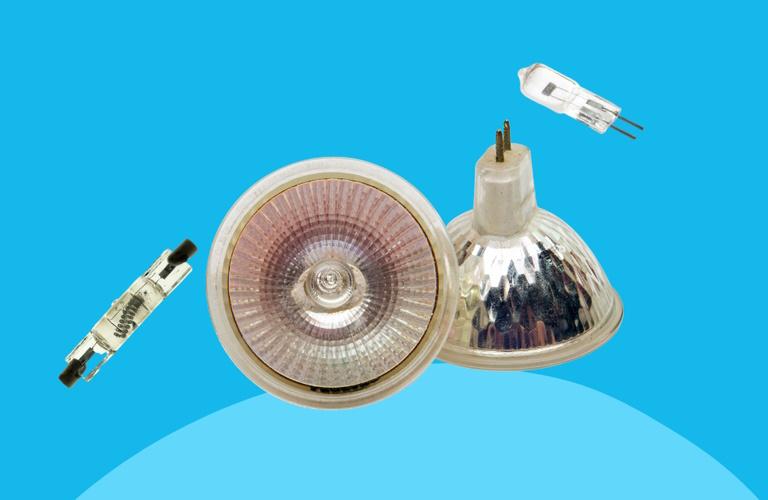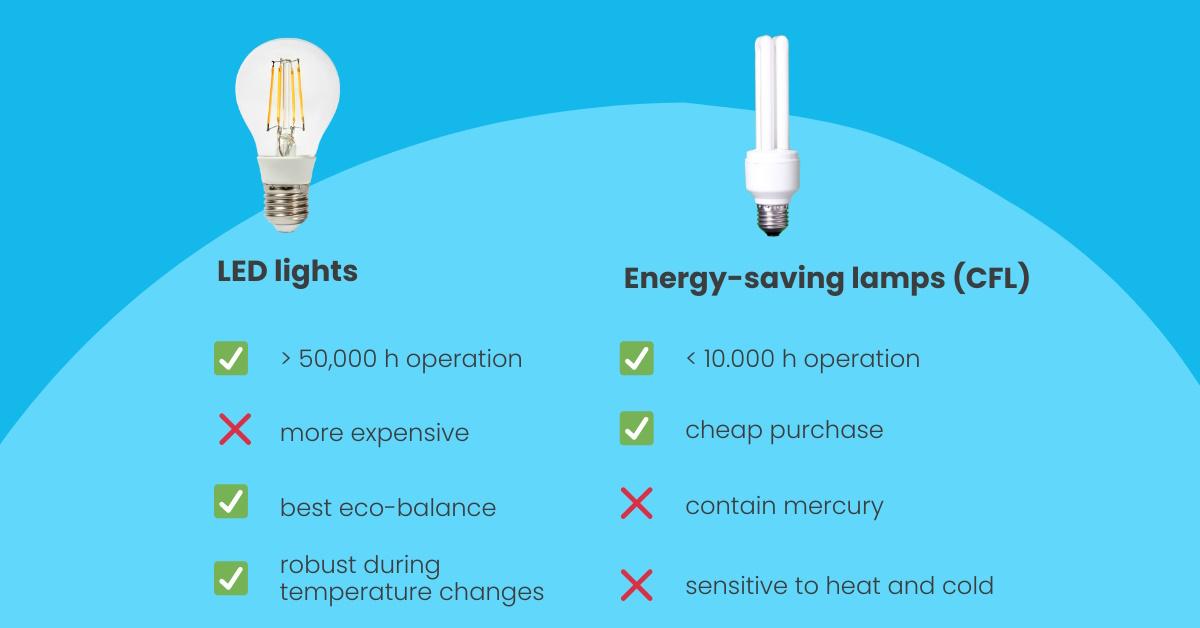
The well-being of your guests and the energy efficiency of your holiday homes are of paramount importance. A simple but effective way to achieve both of these goals is to use the right light sources. In this tutorial, we will explain how to understand the energy classes of light sources and how to use them to best effect in your holiday homes.
Which light sources are available?
Before we delve into the details, it is worth giving you a brief overview: What light sources are there and what properties do they have?

Classic light bulbs
The conventional incandescent bulb was already taken off the market in 2012. In little-used rooms, they can be used up, but since they are rarely switched on there, hardly any electricity can be saved.

Halogen lamps
Halogen lamps consume significantly more energy and generate more heat compared to more energy-efficient alternatives such as LED lamps. It makes sense to replace them.

Energy-saving lamps
Classic CFL (Compact Fluorescent Light) energy-saving lamps are slightly cheaper than LED lights, but have three times shorter life and contain mercury.

LED lights: The ultimate in lighting
The abbreviation LED stands for "Light Emitting Diode". LED lights use about 90% less electricity than old incandescent lamps, 70% less than halogen lamps, and 40% less than CFL energy-saving lamps. Lasting up to 50,000 hours, they are durable, they contain no toxins, produce more lumens per watt than CFLs, and thus have taken energy efficiency to a new level. That is why they are considered the ultimate and the future of efficient lighting.
Why are the energy classes of light sources important?
Before we delve into the details, let us first understand the basic benefit that knowing the energy classes of light bulbs provides to holiday home hosts:
1. Energy savings
Light sources account for a significant portion of the energy consumption in your holiday home. By using energy-efficient light sources, you can reduce energy consumption and thus lower your operating costs.
2. Environmental friendliness
Using light sources with lower energy consumption helps to protect the environment by reducing CO2 emissions. This is not only good for the environment, but also a plus point with environmentally conscious guests.
3. Cost savings for your guests
Energy-efficient lighting sources help reduce your guests' electricity bills, which can increase the appeal of your holiday home.
The energy classes at a glance
The energy efficiency of lamps is indicated by the energy class label, which has a scale from A to G since 2021.

- A: Very efficient
- B bis D: Averagely efficient
- E bis G: Less efficient
The higher the energy class, the more efficient the light source. Be sure to choose bulbs with higher energy ratings to save energy and money.
Which light sources are the best?
No question, there are currently only two sensible light sources when it comes to energy efficiency and the environmental aspect. Let us take a look at a small comparison between conventional energy-saving lamps (CFL) and LED lights:

- LED lamps: LED lamps are clearly the most energy-efficient light sources and offer a long service life. They are a bit more expensive initially, but pay off in the long run.
- Compact Fluorescent Lamps (CFLs): These are a good alternative to traditional incandescent bulbs and are also energy efficient.
Tips for switching to energy-efficient light sources
- Gradually replace old incandescent bulbs with LED bulbs or CFLs.
- Make sure the light sources are suitable for lighting your rooms.
- Consider the colour temperature of the light sources to create the atmosphere you want.
Colour temperatures of light sources
How to choose the right lighting for your holiday home

Now that we have covered the energy classes of light sources, it is time to look at another important aspect of lighting in your holiday home: the colour temperatures of light sources.
The right choice of colour temperature can have a significant impact on the atmosphere and comfort in your premises. Learn how to choose the right colour temperature and which colour temperatures are suitable for different rooms.
The right colour temperature for every room
 The colour temperature of light sources is measured in Kelvin (K) and indicates how warm or cool the light appears. Low Kelvin values produce warm, yellowish light, while high Kelvin values produce cool, bluish light. Here is a rough overview:
The colour temperature of light sources is measured in Kelvin (K) and indicates how warm or cool the light appears. Low Kelvin values produce warm, yellowish light, while high Kelvin values produce cool, bluish light. Here is a rough overview:
- Low Kelvin (below 3,000K): Warm light, similar to the light from candles or incandescent lamps. Ideal for cozy areas such as bedrooms, living rooms and children's rooms.
- Medium Kelvin (3,000K to 4,500K): Neutral white light that provides balanced lighting. Suitable for kitchens, dining rooms and bathrooms.
- High Kelvin (over 6,000K): Cool, daylight-like light that promotes concentration. Perfect for studies and hallways.
Examples for choosing the right colour temperature
- Bedroom (approx. 2,700K): To create a cozy and relaxing atmosphere, warm, yellowish light with a colour temperature of about 2,700K is recommended. This will contribute to the relaxation of your guests.
- Kitchen (about 3,500K): In the kitchen, neutral, slightly cooler lighting of about 3500K is ideal. It provides good visibility when cooking and preparing meals.
- Bathroom (approx. 4,500K or higher): Bright, daylight-like light of about 4,500K is best for the bathroom. This makes personal hygiene and makeup application easier. As is often the case, however, it is a matter of taste: some prefer even higher ranges on the scale from 5,000.
- Work area (approx. 6,000K): If you are setting up a work area in your holiday home, choose a high colour temperature of approx. 6,000K. This will promote concentration and productivity.
Implementation tips
- Use dimmable light sources to adjust brightness and atmosphere as needed.
- Combine different light sources, such as ceiling lights, wall lamps and floor lamps, to create versatile lighting.
- Remember that personal preferences can vary. Therefore, offer some selection of light sources to meet the needs of your guests.
Conclusion
Choosing the right light sources and understanding energy classes are crucial to making your holiday homes energy efficient and environmentally friendly. By using energy-efficient light sources, you can not only reduce your operating costs, but also increase guest satisfaction and help protect the environment.
The right lighting and colour temperature will allow you to create an inviting and cozy atmosphere that will be appreciated by your guests. Therefore, pay attention to the details and create a pleasant atmosphere in your rooms.
We hope that this guide has been helpful to you in choosing and using light sources in your holiday homes.



